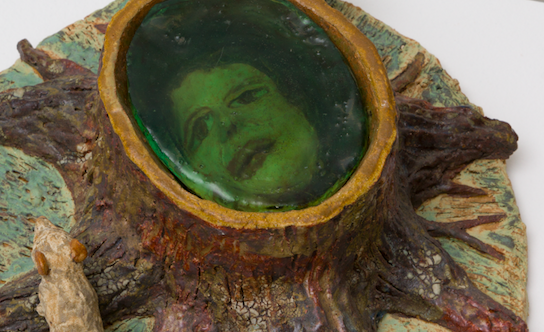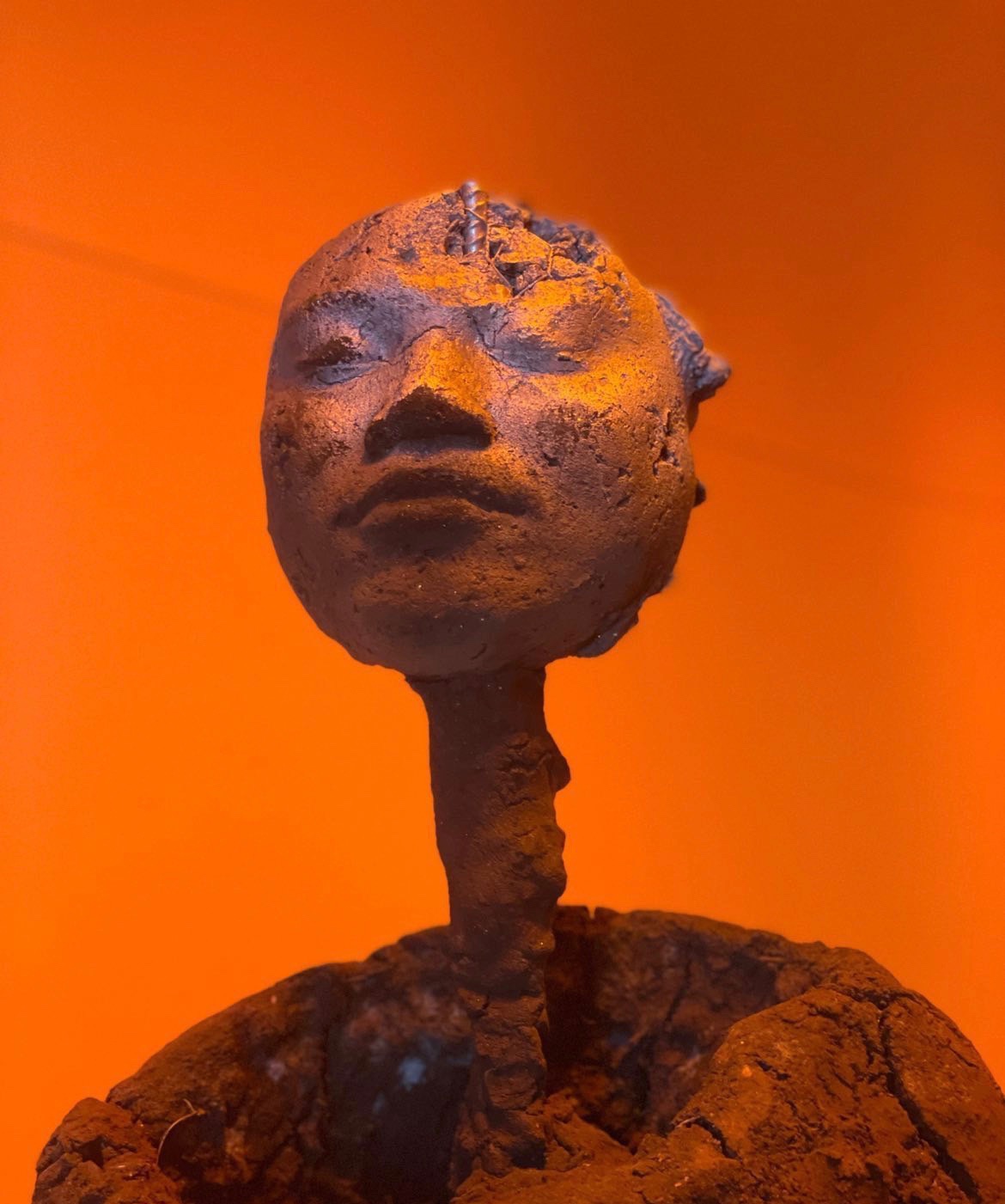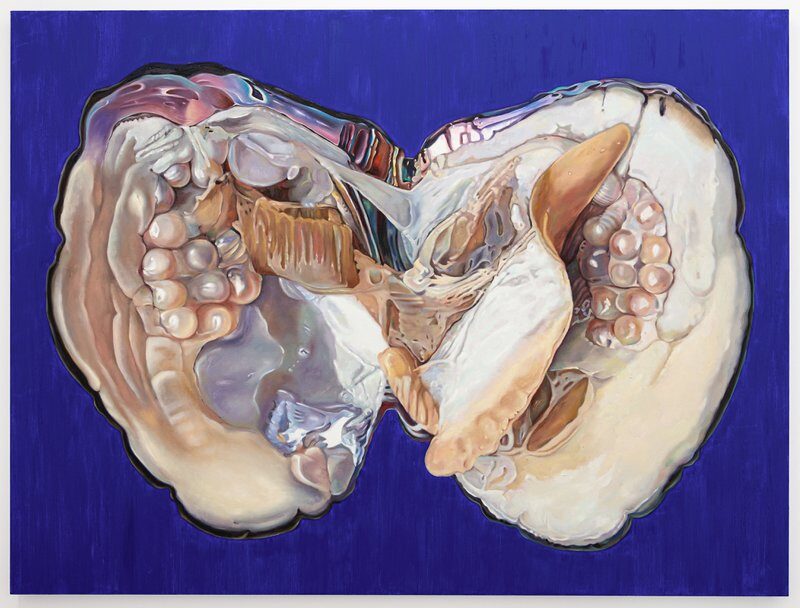Your cart is currently empty!
Tag: ecofeminism
-

PICK OF THE WEEK: The Tale Their Terror Tells
Lyles & KingThe enchanting lure of a hole, the tender scuttle of a bug, the mysterious vibrations of the forest, the pungent bloom of a corpse flower, the mutability of our fleshy bodies in decay—these are things that have fascinated and bonded my years of friendship with Geena Brown. Our co-curated exhibition “The Tale Their Terror Tells” at Lyles & King in New York began as a conversation between friends with a mutual passion for all things dark and grotesque. At the beginning of the pandemic, Geena and I found comfort and joy in watching the horror films that captivated us from adolescence to adulthood (taking inventory in the form of a rather obsessive google spreadsheet that continues to grow). While many of our friends and family found our embrace of horror in a time of peril to be masochistic, we found it generative, playful, and cathartic. The intersection of horror and ecology would become an important source for us to think imaginatively about our survival despite feelings of overwhelming doom and terror. Using the concept “eco-horror,” (as it is applied in film, literature, and visual art) allows us to articulate the collective anxieties of our time and reckon with the daunting uncertainty of our world in crisis. The 23 artists included in the exhibition are guided by the strange, pushing the boundaries of reality and questioning what it means to be human. This kind of curiosity is similar to a child’s sensitivity to the mystifying and unexplainable dimensions of the world. This group of artists reveals a world of haunted topographies crawling with ghosts that whisper tales of desire and fear, casting shadows that trace the violent cost of modern “progress.” These artists practice a kind of radical imagining that calls attention to the vibrant interconnections embedded in everyday life that carry possibilities of resurgence and consider our individual and collective responsibilities. The deep friendship and mutual admiration that nurtured this exhibition speak to the ecofeminist values that frame our curatorial practices and ideas. “The Tale Their Terror Tells” is just one iteration of an ongoing inquiry into eco-horror that will continue to evolve as we leap towards the perils and possibilities of our future.
Artists included in the exhibition:
Angel Lartigue, Astrid Terrazas, Chris Dorland, Chris Hood, Dan Herschlein, Danny Moynihan, Erin Jane Nelson, Farley Aguilar, Felipe Baeza, Hings Lim, Jessica Taylor Bellamy, Josh Kline, Karl Haendel, Kathy Ruttenberg, Kiyan Williams, Lila de Magalhaes, Marlene McCarty, Max Hooper Schneider, Miljohn Ruperto, Mira Schor, Sarah Jérôme, Xie Lei and Zoe Leonard.Lyles & King
21 Catherine St & 19 Henry St
New York, NY 10038
On view through August 22, 2022 -

PICK OF THE WEEK: Kiyan Williams
Hammer MuseumAs my feet touch the terrain of compact, glittering soil that covers the floor of the Hammer Projects space, it feels as if I’m stepping into another realm, another planet even. Kiyan Williams’ solo exhibition, “Between Starshine and Clay,” curated by Erin Christovale, presents a new kind of land art–a sort of archeology of ruins. The artist began collecting earth from ancestral sites in an effort to piece together their own familial heritage. Williams understands soil as vibrant organic material that harbors collective meaning related to Black American histories and identity. Attuned to the spiritual and metamorphic qualities of land and soil, Williams’ practice is echoed in Katherine McKittrick’s claim that “black matters are spatial matters.” In mapping a kind of Black geography that considers diasporic histories and subjects often regarded as “ungeographic”, McKittrick emphasizes the “spatial practices Black women employ across and beyond domination and the ways in which geography, although seemingly static, is an alterable terrain.”
Under the dome of the gallery, a constellation of geological debris and cosmic matter is suspended in a moment of transformation, levitating in a state of simultaneous expansion and explosion; bits of sandstone from the facade of the U.S. Capital constructed by slave labor float alongside pieces of ancestral earth creating a sedimental vortex of Black life. Fragments of the artist’s face and hands are imprinted in the soil as if to suggest their own transformation embedded in the material traces of the “ruined” body. A human figure emerges from the dirt as if springing from the roots of the constellation. An audio recording of Lucille Clifton’s 1993 poem “won’t you celebrate with me” reverberates throughout the gallery, energizing the surrounding materials and bodies. Like Clifton, Williams honors past and present networks of kinship that live in the soil and the stars.
Considering the ways in which humans and nature intersect, Williams presents a new kind of land art grounded in Queer-Black ecofeminism, and land monuments that are not emblems of totality and domination but rather totems of transformation and regeneration.
Hammer Museum
10899 Wilshire Blvd
Los Angeles, CA 90024
On view through August 28, 2022 -

PICK OF THE WEEK: Fawn Rogers
Wilding Cran GalleryFawn Rogers’ exhibition “Your Perfect Plastic Heart” at Wilding Cran Gallery presents a series of paintings depicting oysters and their gooey erotic membranes. At first glance, these works struck me as a cross between Marylin Minter and Chloe Wise–glittery hyperrealist paintings of gastronome with a hint of kitsch. Rogers takes the oyster as her subject to frame the story of our precarious reality as we navigate living and dying in the age of the Anthropocene (a term Rogers uses that I tend to shy away from).
As Rogers points out, oysters have been historically commodified as culinary delicacies–served with lemon and mignonette–and their pearls as a luxury material that signifies wealth and taste. Human fingers creep out of the oyster’s shells, tracing their slimy edges and protruding pearls, eroticizing and likening their forms to female anatomy. The oysters are decontextualized from their natural habitats and painted against nondescript color field backgrounds. As if to evoke an eco-Yves Klein fantasy, the painting titled Epoquetude is foregrounded by a vibrant cobalt blue, further stressing their condition as rarified commodities. I’m left wondering, how does Rogers’ sexualization of nature contribute to the ecofeminist conversation?
While the pearl industry certainly speaks to the story of human exceptionalism and exploitation of nature, another related, resurgent, and collaborative story lies beneath Rogers’ opalescent surfaces. Oyster farming is surprisingly sustainable; not only that, it significantly benefits the ecosystem as oysters are natural filtration systems that promote biodiversity. What is not sustainable is farming and shipping oysters from Maine to Los Angeles. Rogers claims that “the pearl’s inception hinges on corruption, manipulation, and desecration.” While this is true, oysters also contain histories of indigenous harvesting practices. Rogers’ paintings present pearls and mollusks from the vantage point of capitalist consumption to tell an aestheticized story of the Anthropocene. It’s hard to deny the alluring quality of Rogers’ paintings, but they seem to miss vital connections to a more resurgent ecofeminist story, lost in the painting’s erotic surfaces.
While I’m aligned with Rogers’ ecofeminist agenda, I do wonder if her painted critters tell the story of environmental urgency and disaster she aims to inform. Or are oysters just enticing to paint and sexy to look at? Ecofeminism’s strength and potential lie in its commitment to cultivating tentacular thinking, resurgent strategies, and multispecies kinship. As Donna Haraway likes to say, “It matters what thoughts think thoughts. It matters what knowledges know knowledges. It matters what relations relate relations. It matters what worlds world worlds. It matters what stories tell stories.” Rogers’ oyster story is one among many other related (hi)stories of conquest, resistance, and resurgence.
Wilding Cran Gallery
1700 S. Santa Fe Avenue, unit 460
Los Angeles, CA 90021
On view through June 25, 2022


